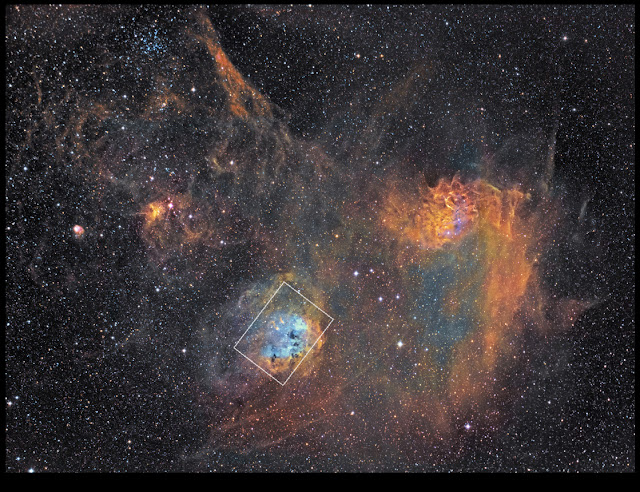COPYRIGHT, PLEASE NOTE
All the material on this website is copyrighted to J-P Metsavainio, if not otherwise stated. Any content on this website may not be reproduced without the author’s permission.
BUY A MUSEUM QUALITY POSTER
BUY A POSTER:https://astroanarchy.zenfolio.com/
Sunday, December 2, 2012
A cosmic fertilization
IC 410, in Auriga
Ra 05h 22m 39s Dec -33° 31′ 01″
HST-palette, (HST=Hubble Space Telescope) from the emission of ionized elements,
R=Sulfur, G=Hydrogen and B=Oxygen.
Emission nebula IC 410 and an open cluster, NGC1893, inside it are located in constellation Auriga about 12.000 light years from my home town Oulu, Finland. The cloud of glowing gas is over 100 light-years across, sculpted by stellar winds and radiation from embedded open star cluster NGC 1893.
"Cosmic tadpoles" are potentially sites of ongoing star formation, they are about 10 light-years long.
Emission from sulfur atoms is shown in red, hydrogen atoms in green, and oxygen in blue hues in this false-color, narrow band composite image above.
A closeup
A closeup about "tadpoles"
Image in visual colors
Natural color composition from the emission of ionized elements, R=80%Hydrogen+20%Sulfur, G=100%Oxygen and B=85%Oxygen+15%Hydrogen to compensate otherwise missing H-beta emission. This composition is very close to a visual spectrum.
Orientation
A study about the apparent scale in a sky
Note. an apparent size of the Moon is marked in the images
Note. an apparent size of the Moon is marked in the images
An experimental study about the 3D-structure
Technical details:
Processing work flow:
Image acquisition, MaxiDL v5.07.
Stacked and calibrated in CCDStack2.
Levels, curves and color combine in PS CS3.
Optics, Meade LX200 GPS 12" @ f5
Camera, QHY9
Guiding, SXV-AO, an active optics unit, and Lodestar guide camera 8Hz
Image Scale, ~0,8 arc-seconds/pixel
15 x 1200s exposures for the H-alpha, emission of ionized Hydrogen = 5h
6 x 1200s exposures for the O-III, emission of ionized Oxygen = 2h
4 x 1200s exposures for the S-II, emission of ionized Sulfur = 1h 20min.
Wednesday, November 28, 2012
Melotte 15 in IC 1805
A new imaging project from the last night, Merlotte 15, the heart of the Heart nebula.
Image shows now just the emission of Hydrogen, H-alpha. I'll shoot other emission channels for the color image soon. 20 x 1200s frames, =6h 40min.
The heart of the Heart
Melotte 15 (Mel 15)
6h 40min. H-alpha light, image spans about 30 arch minutes vertically. (the angular size of the moon is ~30 arch miutes = 0,5 degrees)
The open cluster centered in this image is known as Melotte 15 . Melotte 15 is embedded within a central portion of the much larger glowing nebula identified as IC 1805.
The interesting structure in the center of the image is a giant area of hydrogen gas that is caused to glow by the intense ultraviolet radiation from the massive stars of the Melotte 15 star cluster.
Dust and gas clouds are twisted by the pressure of the intense radiation, the solar wind.
This formation is estimated to be 7,500 light years away from Earth, North is up.
A starless version
This experimental image shows the actual nebula without stars.
Orientation image
The area of interest is marked in this older wide field HST-palette image.
A study about the scale in the sky
Click for a large image
An apparent size of the Moon is marked in the images as a scale.
Tuesday, November 27, 2012
A Zoom in animation about the Veil nebula
I have done several studies about the apparent scale of several objects, to show, how large they really are in the sky. My older studies can be seen HERE (Just scroll down a bit, at the end of the page, click "Older posts" to see more.) I have imaged same targets with several focal lengths, form 200mm up to 3000mm, this time I made an animated GIF out of my material.
Veil Nebula, a supernova remnant in Cygnus
An animated zoom in series, from a four to about a 0,4 degrees field of view
Please, let the animation load first, it's about 2.7MB.
Note. A size of the Moon is marked as a white circle, at the center of the images.
The apparent size of the Moon is ~30', that's equal to 0,5 degrees.
Images used in this animation can be seen here:
http://www.astroanarchy.blogspot.fi/2012/11/veil-nebula-collection-as-poster.html
Labels:
research and development
Monday, November 26, 2012
IC 5146
This is a start of the imaging project. I shot 9 x 1200 s. (3h) H-alpha light for this emission nebula. IC 5146 , the Cocoon Nebula, is a star formation area and locates in constellation Cygnus at distance of about 4000 light years. There is a reflection component but due to narrowband technique used, it's not visible in this Hydrogen emission image. I'll shoot other cahnnels, S-II and O-III, for this later.
IC 5146, the Cocoon Nebula
In constellation Cygnus
Image shows the emission of ionized Hydrogen
Technical details:
Processing work flow:
Image acquisition, MaxiDL v5.07.
Stacked and calibrated in CCDStack2.
Levels and curves in PS CS3.
Optics, Meade LX200 GPS 12" @ f5
Camera, QHY9
Guiding, SXV-AO, an active optics unit, and Lodestar guide camera 8Hz
Image Scale, ~0,8 arc-seconds/pixel
9 x 1200s exposures for the H-alpha, emission of ionized Hydrogen = 3h
Subscribe to:
Comments (Atom)






















